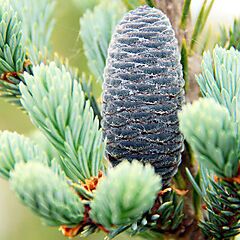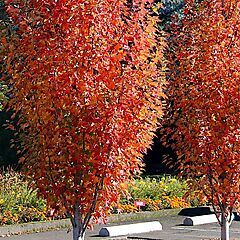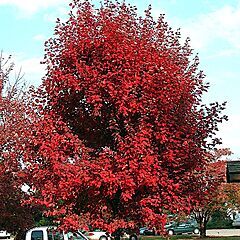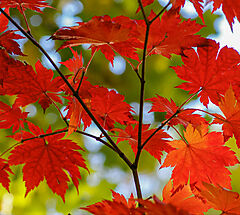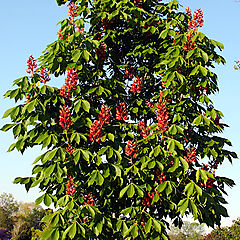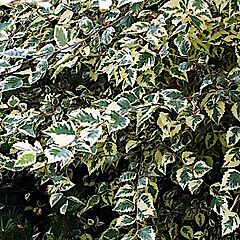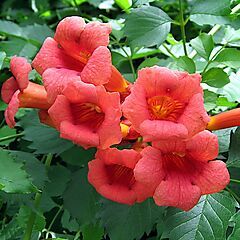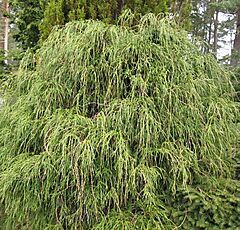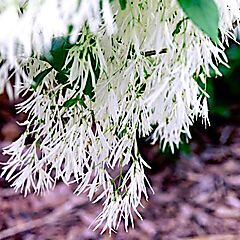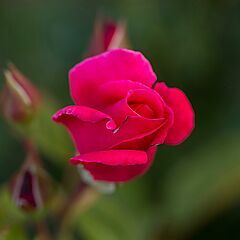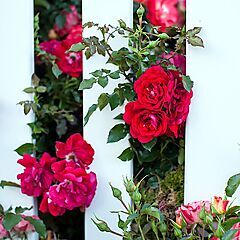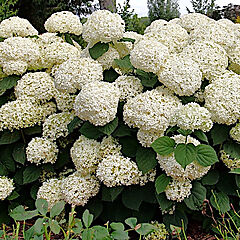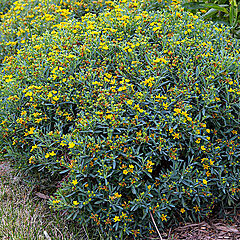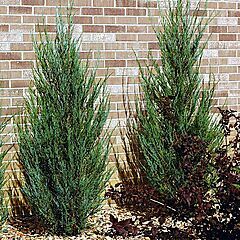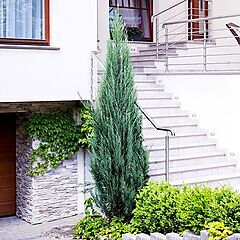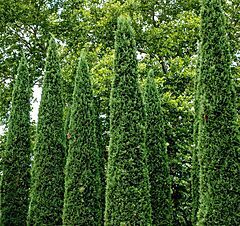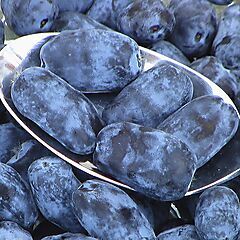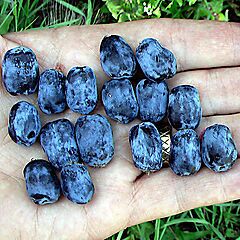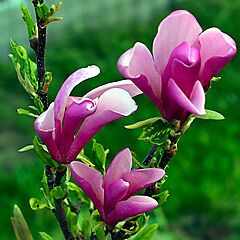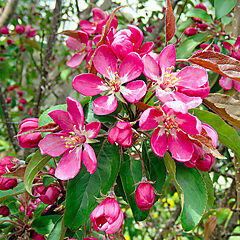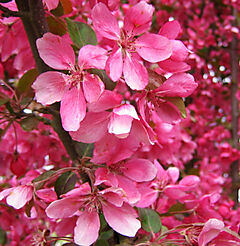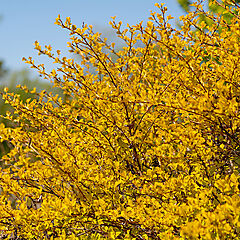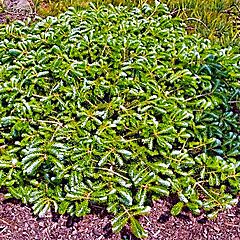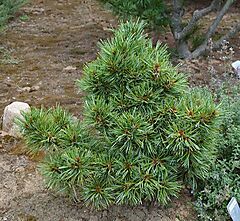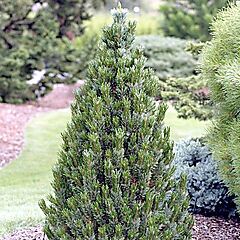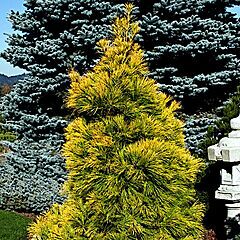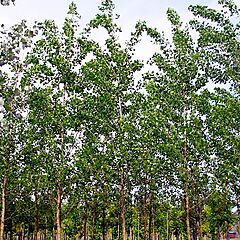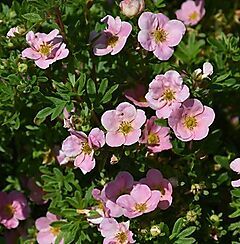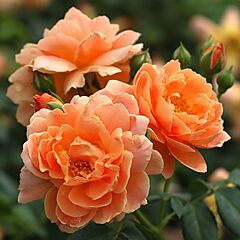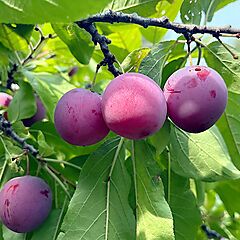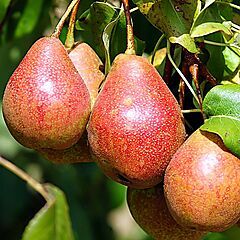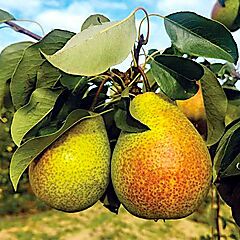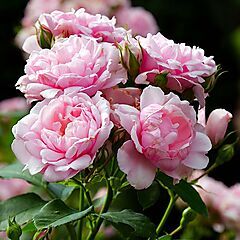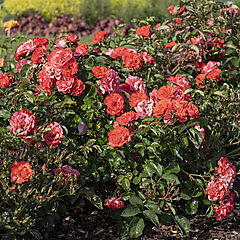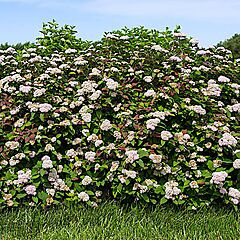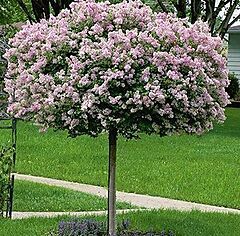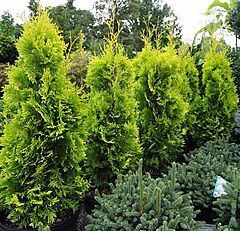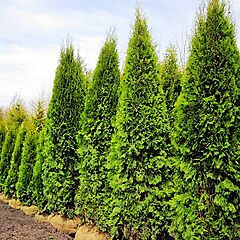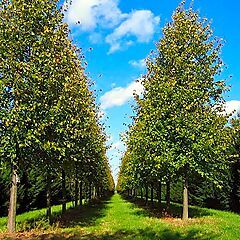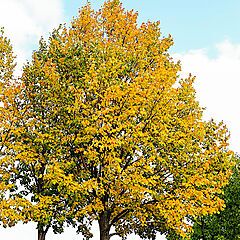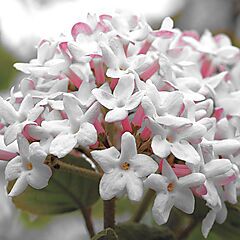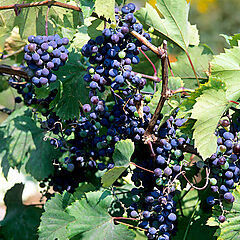New Trees and Shrubs
|
|
Abies balsamea, Tyler Blue Balsam, Fir Maintaining its color in full sun to part shade, this Blue Balsam Fir will stand out in a landscape. With soft-to-the-touch needles, its pyramidal and relatively compact form commands attention. Grows at least 15"/year in optimal conditions. |
|
|
Acer rubrum, Armstrong Gold, Maple Its narrow shape and dense foliage make this Red Maple cultivar very impressive. The columnar shape makes it excellent for street plantings. Glows golden, then orange in the fall. |
|
|
Acer rubrum, Brandywine, Maple This shorter Maple is an excellent choice for lawn, street, and park plantings, as it produces sterile flowers so there is no seedling production. Fall turns this tree red eventually, giving way to a vibrant reddish-purple. Significant leafhopper resistance. |
|
|
Acer rubrum, Red Maple, Maple Classic Red Maple that starts with showy red flowers in the spring. Fall color change occurs about two weeks earlier for this tree than for other Red Maples, going from yellow to orange-red to a brilliant scarlet. Fast growing for a Maple, this variety does best in partial shade and moist soils. Will tolerate wet soils. |
|
|
Aesculus x bushii, Mystic Ruby, Horse Chestnut This native selection features pink-red flowers with improved hardiness compared to thhose of other red-flowered Buckeyes. Shows resistance to leaf blotch and leaf scorch. The coarse foliage provides wonderful contrast with the upright flower panicles. The blooms are attractive to pollinators. |
|
|
Aronia arbutifolia, Berry Scape Red, Chokeberry Native from Ontario down to Texas, Berry Scape Red Aronia is drought, heat, and salt tolerant and adapts to nearly any soil. In spring, an abundance of white flowers cover this shrub before changing to bead-like fruit that will transition from yellow to orange to brilliant red. Red foliage accompanies the fruit for unforgettable fall interest. As a smaller Aronia variety, this shrub will fit into many gardens and landscapes. |
|
|
Betula nigra, Shiloh Splash, River Birch Maintaining the characteristic peeling bark of the River Birches, this tree has green leaves edged in creamy white, which adds a bit of variety to the usual Birch scene. A beautiful accent tree for any landscape, this tree does best in full sun to partial shade, is quite adaptable but prefers to grow in average to wet conditions, and will even tolerate some standing water. While not particular about soil type, it has a definite preference for acidic soils, and is subject to chlorosis (yellowing) of the foliage in alkaline soils. It is highly tolerant of urban pollution and will even thrive in inner-city environments. |
|
|
Campsis radicans, Balboa Sunset, Trumpet Vine Tubular, 3-to-4" dark red flowers in clusters of 6 to 12 create a dramatic show and attract hummingbirds. A clinging vine ideal for screening. |
|
|
Chamaecyparis pisifera, Filifera, Threadleaf (False) Cypress A compelling garden accent because of its long scale-like foliage and irregular mounding habit. New growth emerges bright green then takes on softer tones that complement the reddish brown bark in winter. Excellent candidate for sculpting, as it forms a pyramidal shape over time. Hardy and adaptable to cold and warm climates. Grows 6-10"/year. |
|
|
Chionanthus virginicus, White Fringetree Large panicles covered in white flowers grace this tree in late May/early June. A slow growing native, it prefers deep, moist, fertile, acidic soils and full to partial sun. Highly fragrant flowers are also great for cuttings. |
|
|
Easy Elegance, My Girl Hot pink ruffled blooms in clusters of 5 to 30 age to a lighter pink and open to reveal a golden yellow center. Heat and cold tolerance, disease resistance, and low maintenance reblooming make it an excellent addition to any landscape. |
|
|
Easy Elegance, Paint the Town Clusters of red hybrid tea-shaped full blooms blanket glossy dark green foliage all season long. Everblooming and highly disease resistant to mildew and black spot. This Rose will draw pollinators to any garden. |
|
|
Flower Carpet, Pink Supreme Winner of the world's top honor for disease resistance, 'Pink Supreme' has hot pink blooms that engulf this Rose's ground covering foliage all season, with no deadheading or fancy pruning required. Very heat tolerant. |
|
|
Hydrangea arb., FlowerFull, Smooth Hydrangea Blooming with 2-3 times more blooms than any other Smooth Hydrangea, FlowerFull has been cultivated to have stronger stems holding the big flower heads upright through wind and rain all season. Disease-resistant and growing to only about 4', this low maintenance Hydrangea makes for a great focal point in smaller landscapes. |
|
|
Hydrangea arb., Incrediball Storm Proof, Smooth Hydrangea Storm Proof' was developed with even sturdier stems to hold blooms upright during and after a heavy summer downpour and throughout winter, adding some winter interest to your landscape. Its blooms start out green, quickly turn white, and fade back to green at the end of its cycle. The bloom heads are wonderful for cut flowers, fresh and dried, and the color is not influenced by soil chemistry. |
|
|
Hydrangea mac., Pop Star Endless Summer, Big L.H. A blooming powerhouse, this compact Big Leaf Hydrangea is sure to stun. With deep blue blooms or pink blooms depending on soil pH, you can choose your own color when growing this shrub. Great for cuttings, a simple deadheading will trigger a rebloom. Does best in dappled sunlight or, in warmer areas, with morning sun and afternoon shade. |
|
|
Hypericum, Cobalt-N-Gold, St. John's Wort A fast-growing compact shrub with silver-green foliage covered by yellow flowers from late spring to early summer. Prefers well drained soils. Deer resistant. |
|
|
Juniperus scopulorum, Blue Arrow, Juniper, Colorado Red Cedar Perfect for a vertical accent or screening, this columnar Juniper grows very narrow and upright. Its attractive blue-green foliage maintains a hint of blue throughout the winter, as well as its silvery blue berries. Adaptable to all soils but not tolerant of standing water, it will need to be pruned regularly. |
|
|
Juniperus scopulorum, Skyrocket, Juniper, Colorado Red Cedar Silvery blue-green soft needles give this tall and rigid Juniper year-long interest in a landscape. A dwarf, growing to only 15', it makes an excellent candidate for hedging. Produces silvery blue berries from late spring to late winter. Will need regular pruning. |
|
|
Juniperus virginiana, Taylor's Spruce, Juniper This handsome narrow evergreen maintains a form that is dense and more upright than the forms of similar counterparts. Makes a great privacy screen, an entryway accent, or a dramatic vertical element in the landscape. Is very prone to winter sunburn if not planted in a spot protected from the winter sun. |
|
|
Juniperus x pfitzeriana, Golden Joy, Juniper Maintaining its brilliant yellow color the whole year, this compact, slow growing, spreading Juniper will be sure to add interest year-round to your space. Easy to grow and growing only 3-6"/year, this Juniper stays a manageable size for years. |
|
|
Lonicera caerulae var. kamchatica, Tundra, Honeyberry This is a smaller Honeyberry bush that produces larger fruits. The berries taste like a mix between wild blueberries and black currants. Great for fresh eating or making jams and jellies. Needs 'Aurora' as a pollinator for fruit set. |
|
|
Lonicera caerulea, Aurora, Honeyberry A sweeter and slightly larger berry variety than most honeyberries, 'Aurora' is great eaten fresh, used in baking, or in jams and jellies. Needs a pollinator and serves as a good pollinator for 'Tundra' and 'Borealis'. |
|
|
Magnolia x 'Susan', Susan, Magnolia A compact, mounded hybrid with a low canopy typically about 2' from the ground, this Magnolia will stun with its spectacular fragrant, dark-magenta cup-shaped flowers. Selected for its improved hardiness, it blooms later in spring to avoid frost damage. A wonderful accent in smaller home landscapes, it requires evenly moist, well-drained soil, and will die in standing water. |
|
|
Malus, Courageous, Crab This early blooming, cold hardy Crab has lilac buds that open to a highly fragrant pink bloom in the spring. New growth emerges maroon in the spring, takes on a green-bronze hue in summer, then lights up to a yellow-orange hue in the fall. Maintains its upright, natural form, making it great for group plantings, as its fruit is also sparse compared to that of other Crab varieties. |
|
|
Malus, Rejoice, Crab Flushed with semi-double rose-pink blooms in the spring, this Crabapple maintains a tidy rounded form with little to no pruning. Bears 1 2" burgundy fruits occasionally. |
|
|
OSO Easy, En Fuego This Rose graces the garden with intensely colorful flowers that start off yellow and red, then fully open to an electric orange. The large flower size and glossy green foliage make the fire-like effect especially memorable. It has outstanding disease resistance. |
|
|
Physocarpus opul., Honeycomb, Ninebark Tiny honeycomb-shaped white flowers appear in spring. If trimmed or shaped after the spring bloom, this Ninebark could produce a second flush of blooms. Vibrant chartreuse leaves give this Ninebark appeal all season long before fading to a beautiful gold for the fall. Easily shaped with pruning, or can be left to grow naturally. |
|
|
Picea abies, Cupressina, Norway Spruce, Columnar With its narrow form with branches that grow nearly upright, this columnar Norway Spruce is an excellent selection for places where strong vertical accents are needed. This selection grows at least 15"/year and withstands snow loads better than other fastigiate types. |
|
|
Picea orientalis, Firefly, Oriental Spruce New growth starts a brilliant yellow then softens to gold as the season progresses. Shade will dull the foliage to green, so full sun is best for this compact Spruce. Grows 3-6"/year, reaching only about 6' at maturity. |
|
|
Picea pungens, Bonny Blue, Colorado Spruce A large beautiful Blue Spruce that stands out in a landscape. Having smaller needles and a slower growth rate than other Colorado Spruce trees, this tree develops a large formal stature as it matures. Prefers well-drained soil and full sun, with room to grow. Grows at least 15"/year. |
|
|
Picea pungens, Moonstone Globe, Spruce Smaller than the popular Globe Blue Spruce, this well-mannered little gem has bright blue foliage and maintains a compact, rounded form from youth to maturity. The perfect size and shape for suburban gardens, this cultivar is easy-care and adds a pop of vivid blue to your landscape for years of enjoyment. Grows 1-3"/year. |
|
|
Pinus koraiensis, Blue Ball, Korean Pine A dwarf selection of Korean Pine with blue-green needles that emphasize the blue. Short stiff branches and long needles form a globe-shaped plant that has a bit of irregularity to it. Hardy and adaptable, with minimal disease or insect problems, 'Blue Ball' has great potential in a variety of settings. Grows 1-2"/year. |
|
|
Pinus longaeva, Joe's Bess, Bristlecone Pine Keeping a very true-to-form growth pattern, 'Joe's Bess' has two-toned needles that point toward the tip of each branch and create a consistent shape that hides the stems and buds until new growth emerges in late spring. This tree needs full sun and is slow growing, and it requires little to no pruning. Grows 3-6"/year. |
|
|
Pinus pumila, Blue Dwarf Japanese Stone, Pine Brightly colored cones contrast with the needles in spring and are sure to catch the eye. Dense, twisted needles set this P. pumila variant apart, as does its unique horizontal, spreading habit. A Siberian Pine heritage makes this dwarf very cold hardy for only being a zone 4. |
|
|
Pinus strobus, Louie's Eastern White, Pine A standout Eastern Pine, this tree has long, thin, vibrant yellow needles that stay brightly colored all year long. Interior needles that are shaded fade to green, making the yellow needles really stand out. When planted in full sun, the needles seem to reflect the sun back into your garden. Responds well to an annual shearing, best done when new growth is being put out. Grows 12-15"/year. |
|
|
Populus, Highland, Poplar This cotton-less Cottonwood tree has light-colored bark, much like Populus x acuminata. It is smaller than many other Poplars, which makes it useful for residential plantings. Disease resistant and cotton-less. |
|
|
Potentilla fruticosa, Dakota Sunspot, Potentilla, Cinquefoil Like most Potentilla varieties, 'Dakota Sunspot' will be flush with 1" yellow blooms from early summer all the way until frost. Hardy, tough, and will adapt to all conditions except wet soils. Deer resistant and will attract butterflies, this Potentilla is a relatively low-maintenance shrub. |
|
|
Potentilla fruticosa, Pink Beauty, Potentilla, Cinquefoil Pink flowers adorn this small, rounded shrub from late spring until frost. Tolerant of most soils, it will not do well in wet soils. Flower color is best with afternoon shade and will fade when nights are extremely hot. |
|
|
Proven Winner, At Last Fragrant, full flowers with a true Rose scent and disease-resistant foliage are what made this the 2019 Rose of the Year. Beautiful apricot-peach blooms are self-cleaning and do not require deadheading to rebloom. Will not do well in wet areas, but is otherwise quite adaptable to most soils. |
|
|
Prunus, Pembina, Plum This tree produces a large dessert plum with red skin and sweet, juicy, yellow flesh. Good for eating fresh, cooking, and preserves. Pembina blooms in early spring and will need a pollinator. Cold hardy to zone 2b. |
|
|
Prunus, Waneta, Plum A medium-sized tree that produces abundant red-skinned, yellow-fleshed plums that are perfectly balanced between sweet and tart. Great for eating, baking, and preserves. Needs a pollinator; can use 'Toka' or 'Pembina'. |
|
|
Pyrus, Luscious, Pear For a tree that will produce a sweet and juicy pear, 'Luscious' is a good pick. Fruit is medium to small, and bright yellow. Blooms in early May. Fruit ripens in mid-September and is excellent for desserts, fresh eating, and canning. Fire blight resistant. Use 'Parker' for pollinator. 'Luscious' is pollen sterile and will not pollinate other pear trees. |
|
|
Pyrus, Patten, Pear Fruit is yellow with a red blush and white flesh that is juicy and sweet. Great for eating fresh as well as for using in cooking, baking, and canning. Offers stunning clusters of white flowers in mid spring. Fruit ripens early in the fall and should use 'Parker' Pear for pollination. Turns an outstanding burgundy in the fall. Fireblight resistant. |
|
|
Reminiscent, Reminiscent Pink With the classic Rose scent and full flowers, this Rose is a great thriller piece for a landscape or a container. Blooms from late spring to early fall, making it great for great cut flowers all season long. Excellent disease resistance. |
|
|
Reminiscent, Reminiscent Yellow Part of the Proven Winners ColorChoice brand, this beauty has large double flowers with the classic form and fragrance you expect in a Rose, but with health and vigor that will surprise you. Great for mass plantings, hedges, or cottage gardens. Deadheading is not required for continuous blooms. |
|
|
Salix integra, Hakura Nishiki Tree Form, Willow As stunning in tree form as it is as a shrub, the tree form is sure to be eye-catching in your landscape. Branches reach out with pink stems and buds that open to a gorgeous dappled, variegated pink, green, and white, with the occasional all-white foliage. The stems keep their color, adding nice winter interest to any space. Will grow past the average height and spread if not regularly pruned. The cuttings make great additions to bouquets. Stake trunk until well developed. |
|
|
Shrub Rose, Coral Drift A cross between a ground cover and miniature Rose, this Shrub Rose flowers in a stunning coral-pink with a red overtone. Shrub blooms vigorously and repeatedly from late spring to mid fall. While a highly pest- and disease-resistant option, it attracts bees, making it excellent for smaller gardens or for use along walkways. The flowers are excellent for cutting. This shrub will require occasional maintenance and upkeep, and is best pruned in late winter once the threat of extreme cold has passed. |
|
|
Spiraea japonica, Double Play Dolly, Spirea Spring growth starts our in a beautiful orange-red before transitioning to clean yellow foliage with unique purple flowers. Growing in a neat and compact manner, this Spirea is very strong and easy to care for, making it an ideal choice for low-maintenance yet eye-catching landscaping or container growing. Drought tolerant. |
|
|
Spiraea x fritschiana, Spot On, Spirea A stand-out Spirea all season long, this shrub starts out with bright pink blooms in early June, with sporadic reblooming in the summer. As the season passes, the leaves start becoming dotted with maroon, eventually changing to orange and yellow. Drought tolerant, deer resistant, and low maintenance, this shrub is great when planted in multiples to create a hedge. |
|
|
Syringa meyeri 'Palibin', Dwarf Korean Tree Form, Lilac Same fine features of the shrub-form Dwarf Korean but in tree form! Excellent for an accent in a landscape. Blooms in the early spring with scented flower clusters. Blooms profusely, even at an early age. |
|
|
Thuja occidentalis, Jantar, Arborvitae The eye-popping yellow on this version of Emerald Arborvitae becomes a warmer amber tone during winter, hence the name 'Jantar', which is Polish for "amber". Growing 6-12"/year with the same narrow upright habit as its popular green parent, this selection will add dramatic color to the landscape as a focal plant or privacy screen. |
|
|
Thuja occidentalis, Rushmore, Arborvitae, Eastern White Cedar A dwarf Arborvitae selection from South Dakota, this variety has shown a strong tolerance for harsh winters, even proving resistance to winterburn. Upright and compact growth make this an excellent choice for hedging. Minimal pruning needed. |
|
|
Tilia americana, American Sentry, Linden Fast growing and resistant to insect attacks, this Linden tree is great for vertical accents in a landscape. The dark green foliage turns a glowing gold in the fall, and buttery yellow flowers cluster along the branches in early summer. |
|
|
Tilia x mongolica, Harvest Gold, Linden Upright, oval shape with exfoliating bark, golden buds in summer, and a golden yellow color in the fall. This Linden is perfect for use in locations where spreading canopies are problematic. Cold and heat hardy and resistant to leaf spot and sun scald. |
|
|
Viburnum carlesii, Spice Girl, Koreanspice Viburnum Spice Girl' offers everything you want in a Koreanspice and more: strong growth, fragrance, and colorful flowers. The spring flowers start out a deep reddish-pink and mature to blush white. A much stronger grower than conventional V. carlesii. Deer resistant and shade tolerant, this high-quality foliage plant makes an excellent candidate for border landscaping. |
|
|
Viburnum op., Common Snowball Tree-form, Viburnum Trained into tree form from a favorite Viburnum, this is a great small tree which gets absolutely full of white blooms in late spring. Foliage turns a vibrant red in the fall. |
|
|
Vitis, Frontenac, Grape A vigorous Red Grape vine that will produce clusters of sweet, juicy, deep-purple grapes. Great for juice and wine making, this vine can be used as part of edible landscaping or even hedging/screening. A self-pollinating variety, this vine will need regular care, upkeep, and a pruning regime to reliably produce fruit. |
|
|
Weigela florida, Shining Sensation, Weigela Rich burgundy-purple glossy foliage makes this cultivar stand out all season long. When adorned with its pink trumpet-shaped flowers in late spring and onward, it will attract hummingbirds and other pollinators well into late summer. Should be planted in full sun; otherwise, the dark foliage will fade to green. |
